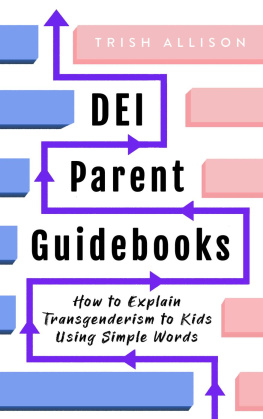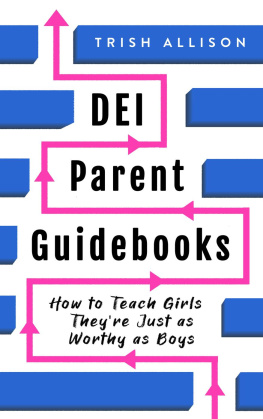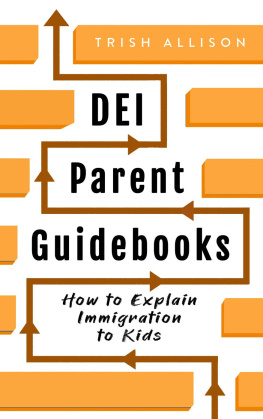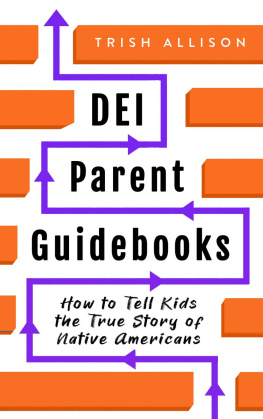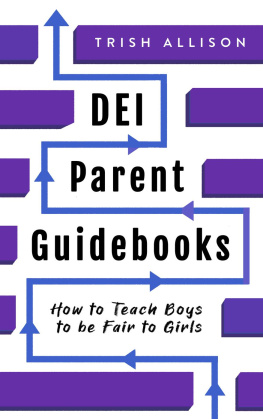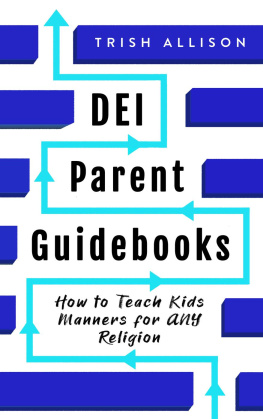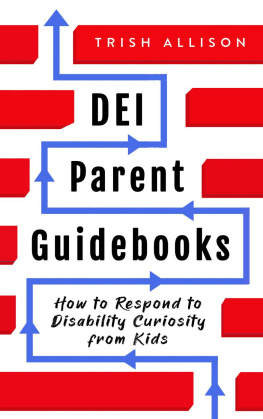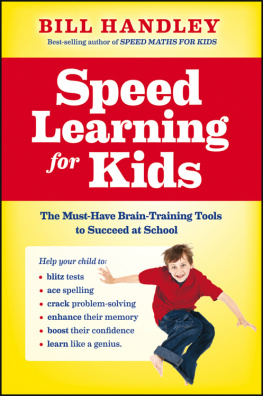How to Explain Transgenderism to Kids Using Simple Words
DEI for Parents
Trish Allison
Published by Trish Allison, 2022.
While every precaution has been taken in the preparation of this book, the publisher assumes no responsibility for errors or omissions, or for damages resulting from the use of the information contained herein.
HOW TO EXPLAIN TRANSGENDERISM TO KIDS USING SIMPLE WORDS
First edition. October 15, 2022.
Copyright 2022 Trish Allison.
ISBN: 979-8201736217
Written by Trish Allison.
10 9 8 7 6 5 4 3 2 1
Also by Trish Allison
DEI for Parents
How to Respond to Disability Curiosity from Kids
How to Explain Immigration to Kids
How to Explain Transgenderism to Kids Using Simple Words
How to Talk to Kids About Poverty and Homelessness
How to Teach Boys to be Fair to Girls
How to Teach Kids Manners for ANY Religion
How to Teach Girls They're Just as Worthy as Boys
How to Teach Kids to Interact with Older People
How to Teach Kids to be Kind to Gay People
How to Tell Kids the True Story of Native Americans
Watch for more at Trish Allisons site.
F irst, this guidebook is not about helping your child understand their own gender identity. Rather, its about helping you proactively and intermittently teach them that transgender people deserve the same kindness and respect as everyone else.
We're thankfully starting to see, however slowly, a shift toward an increasingly-diverse world. Many adults are shedding their biases and realizing that transgenderism is a natural part of life. But we won't be able to enjoy further, sustainable movement in the right direction until we can provide accurate information to the upcoming generation.
As a parent, you don't have to become an expert on the transgender subject. But it is important to teach your kid(s) that everyone has the right to dress, act, and identify in ways that make them feel good and healthy.
Your job is to subtly integrate respect for transgender people into your conversations and activities with your children as they grow. This guidebook provides some practical ways you can do that.
Here are a few things to keep in mind as you're reading:
- Most important, none of the steps are intended to be completed on a single, dictatorial occasion. The intent is to communicate the values described here on a casual, consistent basis over a period of time.
- Tips are written for parents of elementary-school children but theres a wide spectrum of maturity at every age. Some six-year-olds are mature way beyond their years and some ten-year-olds are learning at a different pace than their peers. That said, you know your child best regarding what is and isnt appropriate.
- The chapters are organized linearly, meaning it's best to read chapter 1 first and chapter 5 last. That said, if you have an immediate concern, feel free to read whichever chapter is the most pertinent at the time.
- Many of the tips assume that you and your child already share a fairly solid foundation of mutual communication. The tips are doable without this foundation, but they'll be much harder to implement successfully without it.
- It's so important to praise kids when they do something that's aligned with whatever you taught them. Be specific with your praise and look them in the eyes when you say it. Your approval means more than you think.
- It's true that children are heavily influenced by teachers and peers, but ultimately, the values they carry with them into adulthood are learned at home.
Finally, while theres no one-size-fits-all approach for teaching kids understanding and respect for transgenderism, this guidebook provides suggestions for scenarios that you can tailor to fit your own situation. The ultimate goal is to help you raise compassionate, non-biased, successful humans.
Chapter 1: Learn What Your Child Already Knows About Transgenderism
T his chapter appears first because it's important for you to find out what your child already knows about transgenderism before you start guiding them. If you start saying things they already know, they're likely to tune out.
Maybe s/hes already learned about transgenderism, but the facts aren't accurate. Or maybe s/he knows next-to-nothing about the subject and youre starting with a blank slate. Either way, youll never know until you get them talking and really listen to their opinion.
Even if your child is clearly uncomfortable talking about transgenderism, its important to broach the subject and try to help them feel more comfortable talking about it. To successfully guide your child through the maze of shifting awakenings about transgender people, its imperative to help them feel comfortable so you can learn what s/he already knows.
Step 1. Get your child to share their thoughts
The best way to get most children to open up is to say the minimum. If you use short phrases that reassure and prompt, you're more likely to get a response. The goal here is to get your child feeling comfortable enough to express how they feel.
The other crucial element is timing. Trying to start a conversation when your child is playing a game (digital or otherwise), reading, or watching TV almost never works. They'll probably find your presence intrusive before you even start talking. Plus you won't have their full attention.
If it's not the right time, wait. As many parents know, timing is everything, especially when you're trying to understand your child's true feelings.
If it is a good time, here are some ideas for sparking a conversation about transgenderism:
Current Events. News about transgenderism seems to be appearing more and more. Hopefully mentioning one of the subjects below will prompt a reaction:
- Do they know that parts of society are starting to treat transgender people with more dignity than ever before?
- Do they know that positive portrayals of transgender people are starting to appear on popular TV shows and movies?
If your child perks up when you mention either of the subjects above, offer to explore further together. A simple Google search should enable you both to learn more. If they're not interested in learning more, leave it alone for now and bring up the subject again at a later time.
Books. If your child is too young to be interested in current events, reading a book together about transgenderism is a great way to start a conversation because it's not a face-to-face activity. There's a better chance your child will divulge what they already know when they dont have to make eye contact.

